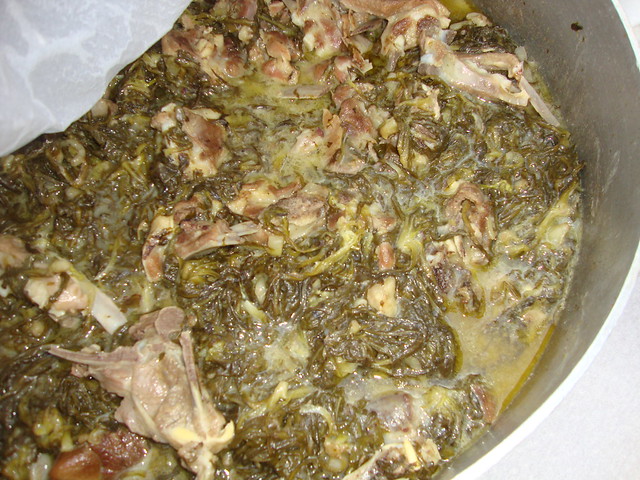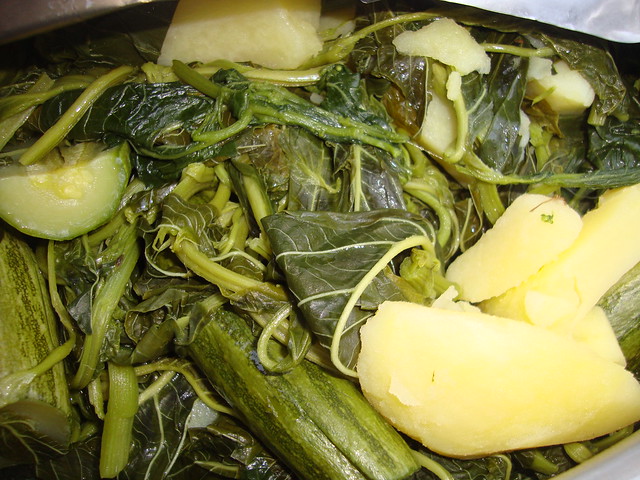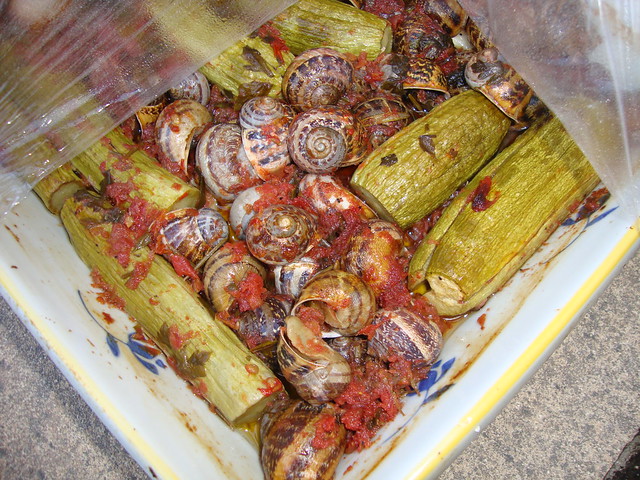Growing up in New Zealand, my home food was essentially
Greek – except during the Easter period, when it was essentially
Cretan. When I found myself among other Greek-Kiwis, they would be
comparing the souvla, kokoretsi and mayiritsa that they ate on Greek
Orthodox Easter Sunday (Catholic – or Calendar Easter – was only viewed
as a public and not religious holiday among the Greek-New Zealand).
That was quite a different meal to the one I ate on that same day,
which consisted of kreatotourta, kalitsounia and gardoumakia, all
Cretan Easter specialities. We were all diaspora Greeks, and even
though our language and food were essentially the same, the dialect of
each one of these collective elements of our Greek identity was quite
different.
In the traditional family setting, ‘Mother’ is usually the first person we associate with food. It is insignificant whether she is a good cook or not – she plays the most basic role in the food identity of a person, because she is most likely the first person to bring food to us, our first point of reference in our nutrition. The role of the mother can be played by other actors: sometimes, it is actually the father who does most of the cooking in a family, while other times, it is a grandmother - or even a servant, as in the case of wealthy families in the US/UK in the 19th century. Our first contact with food in this traditional setting will involve that one person. "Mother’s food" will form an integral part of our food memories, regardless of how we feel about it. The cuisine is not important at this stage, nor is the quality of the food; in the case of the immigrant, there is a strong bond with food from the homeland, as this excerpt attests:
"... the foods of home, no matter how meagre, could haunt the immigrant - especially at life's most critical moments... a dying Irish seamstress... [in] New York... in the 1860s... [was] abandoned by her husband, lived with her two children in a tenement on the west side of Manhattan... She has no more fears or anxieties, she is not even troubled about her little one... We asked her about her food. She said she could not relish many things, and she often thought if she could only get some of the good old plain things she ate in Ireland at her brother's farm she should feel so much better. I told her we would get her some good genuine oatmeal cake from an Irish friend. Her face lighted up at once, and she seemed cheered by the promise." (97 Orchard by Jane Ziegelman, 2010)
Growing up in New Zealand, before I reached my teenage years, I did not eat horta, even though they were a very integral part of my mother's food. To me, horta were a source of embarrassment. Horta were not available at the vegetable market; no one ever mentioned them at school, apart from only a few other Greek children (and usually as a common source of chagrin). The wild-growing grasses (notably dandelion) that my mother collected in the green belt zones of Wellington's rolling hills and parks looked like something sheep would eat. For some reason, they did not fit in with the notion of 'food', as I had formed it, in the context of mainstream New Zealand, despite my immigrant upbringing and the frequency with which horta were served in our house.
I don't quite remember how I started eating horta, although I do have a clear image of myself sitting at the kitchen table of our house before we renovated it, eating horta for the first time, while my parents looked on. I was surprised by their fresh taste, their cathartic lemony tang and their oily goodness oozing down my throat as their slightly crunchy stems yielded a nutty flavour. I also recall that my parents did not have a look of surprise on their face as they watched their first-born enjoying her first wild greens. In fact, it was quite the opposite; the message I got from my mother's face was something like: 'Επιτέλος, έβαλες μυαλό' (finally, you have come to your senses).
The food my mother cooked at home resembled as much as possible the food that she had eaten when she herself was growing up - the only exception being that tehre was a greater amount of meat on our plates in New Zealand than there ever would have been in Crete. Living in a foreign country did not stop my parents from preparing Greek/Cretan food. Mother would make her own mizithra from cow's milk (via bottles, recalling the fresh milk deliveries of the past), she foraged wild greens from the local parks, she used the whole lamb (innards included, which were never displayed in butchers’ windows) that Father bought from a farmer to make the Cretan Easter specialties, and they both shopped at the Italian grocer's for Spanish olive oil, Kalamata olives and freshly ground Greek coffee. On the rare occasions that they visited their homeland, they returned with loukoumia in their suitcases and Greek vlita (amaranth) seeds in their coat pockets (one way to avoid customs back in those days). Greek food imports to New Zealand were limited, but the majority of Mother’s food was prepared using whatever resources were available.
It was when I moved permanently to Crete that I realised the significance of horta in my mother's family cooking. It was also at this time that I discovered the importance my mother attached to snails as food, which she prepared on a regular basis in New Zealand. That was probably the only "mother's food" that I never tried. Now that I cook and eat them myself, I realise what a terrible mistake I made in my misguided youth. By the time I realised this, it was too late to try my mother's snails, because by that time, she had already died. By denying myself the opportunity to enjoy my mother's food, I had denied myself a part of my own identity.
*** *** ***
All the above photographs (except the gardoumakia) were taken in the village of Karanou, Hania, during the First Symposium on Greek Gastronomy, which took place in July of this year. They depict meals cooked on a daily basis by the women of this village, to be eaten in the family home. The meals are all frugal in nature and environmentally friendly, making use of the locally-grown wild and garden greens, and the environmentally friendly approach of the head-to-tail use of animals used as food. The meals do not always look appetising, and they may also look 'poor' with their use of primitive ingredients (which are now being used in the creative cuisine of the affluent) and their lack of sophisticated cooking techniques (despite the fact that they require more cooking skills than, say, preparing a fancy raw salad). But such dishes represent the food of the Cretan people, and they have sustained them for the last two centuries at least. I'll bet many a Cretan woman will remember the first time she cooked each one of these meals (in the same way I do), and how her eaters - especially her children - felt after she had nourished them with it.
©All Rights Reserved/Organically cooked. No part of this blog may be reproduced and/or copied by any means without prior consent from Maria Verivaki.




Very interesting. What is gardoumakia? I suppose I could Google it but just thought I'd ask you!
ReplyDeleteI have been reading a lot about Italy this Summer and am finally realizing the origins, and also the reasons that we eat the things we do. It was all because of extreme poverty in the past.You ate what you could grow or forage and nothing else. My own heritage is Norwegian and I can remember refusing to eat a thing called blotklub (probably spelled wrong) because we kids knew it had cow's blood in it. I still probably wouldn't try it, silly me.
I like the idea of foraging for food. I have tons of dandelion greens growing all over my garden, but....do I pick and eat them? NO. Just too lazy, I guess. But we are learning. My brother forages for wild mushrooms and sells them to fancy restaurants. We raise two pigs every Summer and this year instead of sending them away for processing my husband is going to do it himself. He/we should do that because we are gradually trying to produce more and more of our own food. It's a bloody lot of work!
gardoumakia are made of tripe which has been tied with sheep intestines (really yummy, even tho it sounds gross...)
ReplyDeletegreat idea about the pigs - sounds like hard work, but in the end, you feel very good with yourself about doing it
The point is on frugality, this is where good cooking skills are essential to enhance all the "poor" ingredients. Modern day television cooking uses so many and so rich ingredients in a dish that an old mama cook could make 2-3 dishes out of them.
ReplyDelete